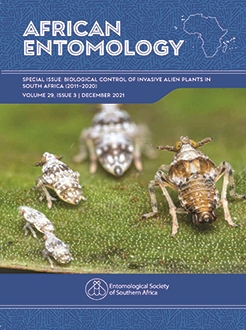The use of plant pathogens for biological control (biocontrol) of invasive alien plants in South Africa was reviewed in 1991, 1999 and 2011. In this review, subsequent progress and projects undertaken in the years 2011 to 2020, on both classical agents using exotic pathogens and inundative agents using indigenous pathogens, are detailed. We report on the impact of several previously introduced exotic fungi, monitored during this period. A significant highlight is the completion of 30 years of annual monitoring, from 1991 until 2020, of the impact of Uromycladium morrisii Doungsa-ard, McTaggart, Geering & RG Shivas (Raveneliaceae) on the density of Acacia saligna (Labill.) Wendel (Fabaceae), with declines of up to 98% recorded at monitored sites. Post-release monitoring also suggested that Entyloma ageratinae R.W. Barreto & H.C. Evans (Entylomataceae), introduced when Ageratina riparia (Regel) R.M.King & H.Rob (Asteraceae) still had a very limited invaded range in South Africa, has prevented the weed from realizing its potential as an invader. Uromycladium woodii Doungsa-ard, McTaggart, Geering & R.G. Shivas (Raveneliaceae) has been established on Paraserianthes lophantha (Willd.) I.C.Nielsen (Fabaceae), as has Puccinia xanthii Schwein (Pucciniaceae) on Parthenium hysterophorus L. (Asteraceae). Prospodium transformans (Ellis & Everh.) Cummins (Raveneliaceae) failed to establish on Tecoma stans (L.) Juss ex Kunth var. stans (Bignoniaceae), while efforts to release Puccinia lantanae Farl. (Pucciniaceae) on Lantana camara L. (Verbenaceae) are underway. Of the established exotic pathogens that are classical biocontrol agents, two are considered to cause extensive damage, two considerable damage, and two moderate damage, to their target weeds. Puccinia arechavaletae Speg. (Pucciniaceae), an adventive fungus that is established on Cardiospermum grandiflorum Sw. (Sapindaceae) following an unknown path of introduction, is proving to be a damaging agent and the implications of its presence in the country are discussed. Early season augmentation of Puccinia eupatorii Dietel (Pucciniaceae) on Campuloclinium macrocephalum (Less.) DC. (Asteraceae) was tested to determine whether damage could be increased, but no difference in the rust's incidence and severity was evident between augmented and naturally infected plants at the end of the growth season. The identity of the indigenous fungus registered as Stumpout®, for the control of coppice growth after felling of Acacia mearnsii De Wild. (Fabaceae), was confirmed as Cylindrobasidium torrendii (Bres.) Hjortstam (Physalacriaceae) rather than C. laeve (Pers.: Fr.) Chamuris, as previously thought. The application of another indigenous fungus, Colletotrichum acutatum J.H. Simmonds (Glomerellaceae), by means of helicopter flights has facilitated its establishment on Hakea sericea Schrad. & J.C. Wendl (Proteaceae), in inaccessible mountainous terrain. For registration purposes, toxicity testing (oral rat LD50) of these indigenous fungi are required. Lethal doses of Cylindrobasidium torrendii, C. acutatum and Pseudolagarobasidium acaciicola Ginns (Phanerochaetaceae), the latter for use against Acacia cyclops G. Don. (Fabaceae), exceeded 2000 mg kg–1 body weight and all three fungi are thus considered safe for application.
How to translate text using browser tools
31 December 2021
Plant Pathogens and Biological Control of Invasive Alien Plants in South Africa: A Review of Projects and Progress (2011–2020)
A.R. Wood,
A. den Breeÿen
ACCESS THE FULL ARTICLE
It is not available for individual sale.
This article is only available to subscribers.
It is not available for individual sale.
It is not available for individual sale.

African Entomology
Vol. 29 • No. 3
December 2021
Vol. 29 • No. 3
December 2021
classical biocontrol
inundative biocontrol
weed pathology





